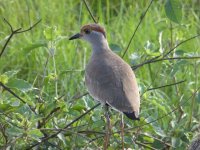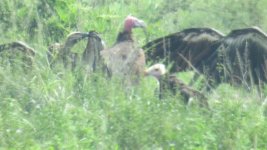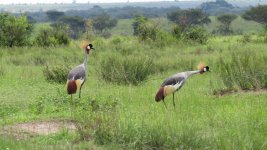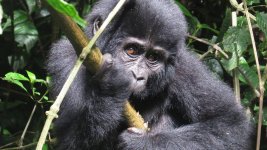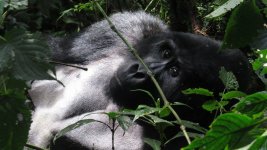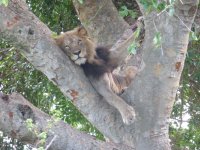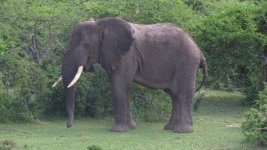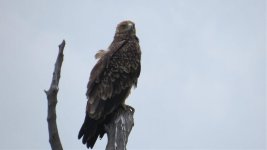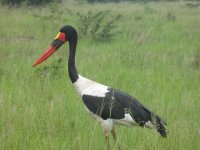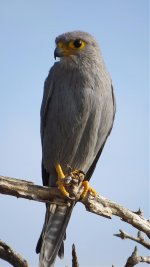dwatsonbirder
Well-known member
Introduction
Uganda is a popular destination for eco-tourism as a result of its varied biomes, rich wildlife and stability. Many tourists visit the country specifically to observe the great apes; Mountain gorilla and Chimpanzee, and it was predominantly for this reason that my partner and I chose to spend 2 weeks there.
The range of other wildlife is impressive too, with at least 16 species of primates, as well as enigmatic megafauna such as elephants, hippos, lions, buffalo etc.
The avifauna is staggering; over 1000 species have been recorded, a figure that is perhaps all the more exceptional as the country is landlocked.
We followed the usual route and visited the following sites; Lake Mburo, Bwindi Impenetrable forest, Queen Elizabeth National Park (Ishasha and Myewa), Kibale, Budongo Forest, Murchison Falls and of course, Mabamba swamp. In visiting these sites we were able to visit a good selection of habitats and altitudes and as a result had a very successful trip, seeing all bar two of our mammal targets, and I caught up with pretty much all of the birds I’d hoped to see. I had hoped to see around 300 species, and had a few specific target species; both Trogons, Martial Eagle, White headed vulture, as many chats/barbets/kingfishers as possible and of course Shoebill - a species I’ve wanted to see in the wild since I was about 12 years old.
As we were driving ourselves, the actual time in the field was somewhat reduced and if one had more time you could see a massive selection of species, as well as catching up with some tricky birds, for example, we did not try for Green breasted pitta at Kibale, nor did we have sufficient time in Budongo to try for Yellow footed flycatcher. It’s always nice to have an excuse to go back to these countries though!
Logistics and general information
As we generally travel on a tight budget, we opted to self-drive and generally camped rather than spend more money on accommodation; even so, the total cost for the trip was approximately £5000 for the two of us for 15 days.
We hired a vehicle from Roadtrip Uganda, and I cannot recommend them highly enough - the level of support if required is fantastic, and they were also able to sort our trekking permits in advance. They provide 24hr breakdown assistance, a mobile phone and can provide a full camping set up. The daily cost of our vehicle and all camping equipment was approximately $55. We travelled approximately 2000km, which translated into approximately $200 in fuel, which was pretty good value.
Accommodation varied, and we found some excellent places to camp. Prices ranged from $10 - $45 per night for our accommodation, I will briefly outline the locations and prices in the various legs of the trip. Food was readily available and generally cheap - we had a couple of relatively fancy meals on our last two nights in Entebbe, but even with a few drinks the total bill came to less than $40.
Roads were variable; there is a lost of investment in infrastructure from the Chinese and quite a few large projects are underway. Once these are finished it is likely this will cut down the amount of time spent travelling between locations. Some roads such as Kyenjojo to Hoima were truly awful - Google estimates about 3.5hrs but in reality this single stretch took over 5hrs. Other areas were better (but still unmetalled roads) and other stretches such as Masindi to Kampala were pretty much at European standards.
From a birding perspective there were a few key resources; the excellent trip report by Dries Van de Loock was a key source of information. A copy of the Helm Birds of East Africa is essential, and I also downloaded a few calls from the Birdsounds app prior to leaving.
We used only two specific birding guides; for Budongo I strongly recommend Raymond +256777319865 or +256752930065 who has an incredible knowledge of calls and is very sharp. We did a mornings birding and paid him $30, which was excellent value in my opinion. We also used a guide for Mabamba swamp which was arranged at the very last minute by a hotel manager (Liam +256778303681 at Precious Accommodation in Entebbe) - the guide was excellent and the charge was $120 for 4 people for approximately 4hrs.
I will attempt to write the report of each of the stages as soon as possible, but please bear with me - it’s October and I will likely be in the field rather a lot over the next 4 weeks!
Uganda is a popular destination for eco-tourism as a result of its varied biomes, rich wildlife and stability. Many tourists visit the country specifically to observe the great apes; Mountain gorilla and Chimpanzee, and it was predominantly for this reason that my partner and I chose to spend 2 weeks there.
The range of other wildlife is impressive too, with at least 16 species of primates, as well as enigmatic megafauna such as elephants, hippos, lions, buffalo etc.
The avifauna is staggering; over 1000 species have been recorded, a figure that is perhaps all the more exceptional as the country is landlocked.
We followed the usual route and visited the following sites; Lake Mburo, Bwindi Impenetrable forest, Queen Elizabeth National Park (Ishasha and Myewa), Kibale, Budongo Forest, Murchison Falls and of course, Mabamba swamp. In visiting these sites we were able to visit a good selection of habitats and altitudes and as a result had a very successful trip, seeing all bar two of our mammal targets, and I caught up with pretty much all of the birds I’d hoped to see. I had hoped to see around 300 species, and had a few specific target species; both Trogons, Martial Eagle, White headed vulture, as many chats/barbets/kingfishers as possible and of course Shoebill - a species I’ve wanted to see in the wild since I was about 12 years old.
As we were driving ourselves, the actual time in the field was somewhat reduced and if one had more time you could see a massive selection of species, as well as catching up with some tricky birds, for example, we did not try for Green breasted pitta at Kibale, nor did we have sufficient time in Budongo to try for Yellow footed flycatcher. It’s always nice to have an excuse to go back to these countries though!
Logistics and general information
As we generally travel on a tight budget, we opted to self-drive and generally camped rather than spend more money on accommodation; even so, the total cost for the trip was approximately £5000 for the two of us for 15 days.
We hired a vehicle from Roadtrip Uganda, and I cannot recommend them highly enough - the level of support if required is fantastic, and they were also able to sort our trekking permits in advance. They provide 24hr breakdown assistance, a mobile phone and can provide a full camping set up. The daily cost of our vehicle and all camping equipment was approximately $55. We travelled approximately 2000km, which translated into approximately $200 in fuel, which was pretty good value.
Accommodation varied, and we found some excellent places to camp. Prices ranged from $10 - $45 per night for our accommodation, I will briefly outline the locations and prices in the various legs of the trip. Food was readily available and generally cheap - we had a couple of relatively fancy meals on our last two nights in Entebbe, but even with a few drinks the total bill came to less than $40.
Roads were variable; there is a lost of investment in infrastructure from the Chinese and quite a few large projects are underway. Once these are finished it is likely this will cut down the amount of time spent travelling between locations. Some roads such as Kyenjojo to Hoima were truly awful - Google estimates about 3.5hrs but in reality this single stretch took over 5hrs. Other areas were better (but still unmetalled roads) and other stretches such as Masindi to Kampala were pretty much at European standards.
From a birding perspective there were a few key resources; the excellent trip report by Dries Van de Loock was a key source of information. A copy of the Helm Birds of East Africa is essential, and I also downloaded a few calls from the Birdsounds app prior to leaving.
We used only two specific birding guides; for Budongo I strongly recommend Raymond +256777319865 or +256752930065 who has an incredible knowledge of calls and is very sharp. We did a mornings birding and paid him $30, which was excellent value in my opinion. We also used a guide for Mabamba swamp which was arranged at the very last minute by a hotel manager (Liam +256778303681 at Precious Accommodation in Entebbe) - the guide was excellent and the charge was $120 for 4 people for approximately 4hrs.
I will attempt to write the report of each of the stages as soon as possible, but please bear with me - it’s October and I will likely be in the field rather a lot over the next 4 weeks!




